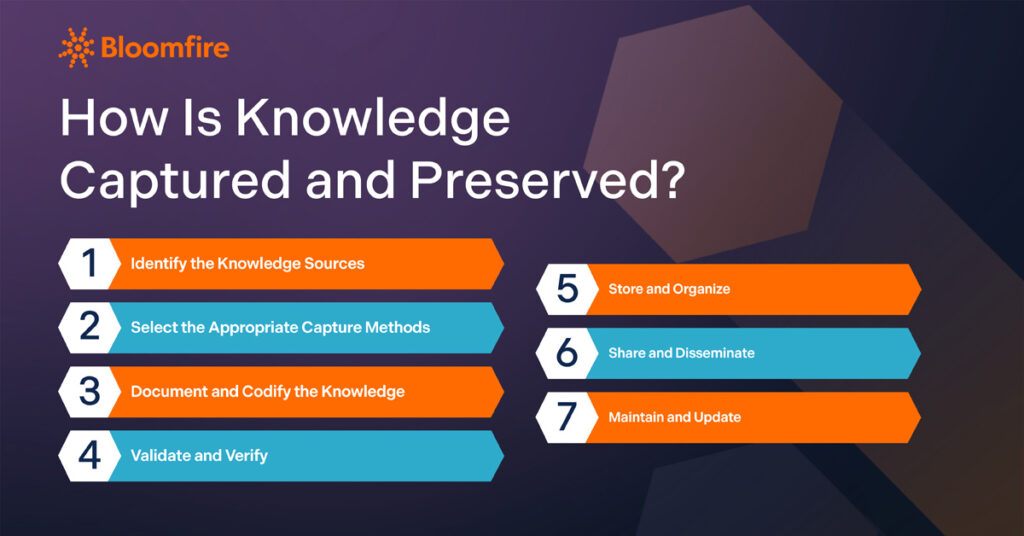Knowledge Retention: How to Capture and Preserve Knowledge at Work

As humans, we are wired to forget. According to the concept known as the forgetting curve, individuals tend to forget approximately 50% of the information they hear within one hour. Fortunately, there are knowledge retention strategies you can use to improve your recall of information.
In any workplace, the ability to retain knowledge drives productivity and fosters innovation. Employees frequently encounter valuable insights and skills that, if not properly documented, may be lost when they leave the organization or change roles.
What can you do to reinforce the retention of knowledge and preserve critical information within your organization? Below, we explore the basics of knowledge retention and how you can make sure your organization doesn’t “forget” any necessary information for the long haul.
What Is Knowledge Retention?
Knowledge retention refers to the process of absorbing and retaining information. For an individual, this typically involves taking in information and transferring it from short-term to long-term memory. For example, do you remember the state capitals you learned in elementary school? That’s individual knowledge retention.
However, the concept appears different when applied to organizations. Knowledge retention refers to the systematic process of capturing, storing, and managing information within a company. This includes processes, best practices, product details, and other relevant data or information, ensuring it remains accessible and usable over time.
Discover the Power of Knowledge Management
Our guide shows how making knowledge accessible impacts performance and retention.
Download our report
This is why retained knowledge isn’t just a nice-to-have—it’s an essential to help companies run efficiently and maintain a competitive advantage. Specifically, here’s why:
1. Knowledge retention makes information transferable
Knowledge retention is a proactive organizational effort to preserve the critical expertise and insights held by individual employees. It is done by extracting and storing this information in a readily accessible, company-owned repository, such as a comprehensive knowledge base.
Once this valuable intellectual capital is documented, organized, and centralized, it becomes a shared asset that the company can access and transfer efficiently, regardless of an employee’s availability or departure. This process safeguards against losing vital operational knowledge and streamlines onboarding and training for new staff. It also accelerates problem-solving by making solutions and best practices easily discoverable, ultimately enhancing the organization’s overall resilience, adaptability, and capacity for innovation.
2. Critical knowledge stays within the company
When knowledge resides only with specific employees, its potential is limited to their immediate use. A comprehensive retention approach transforms this fragile personal expertise into a shared organizational asset.
Having Enterprise Intelligence in your company accelerates the onboarding of new team members and empowers better-informed decision-making across departments. Plus, it minimizes costly errors stemming from a lack of information and fuels innovation by drawing upon past successes and lessons learned. Essentially, making knowledge a communal resource fortifies the company’s capabilities and adaptability over time.
3. New employees are onboarded more quickly
A well-organized knowledge base serves as the single source of truth for all essential company information and procedures. This significantly reduces the need for existing employees to repeatedly answer common questions from new hires, freeing up valuable time, undoubtedly, one of the biggest benefits of a knowledge base.
Learners can independently explore topics relevant to their roles and learn at their own pace. Providing consistent, reliable information accelerates their path to becoming fully productive team members, reducing the time and resources traditionally allocated for repetitive training sessions.
4. Current employees access the knowledge they need more efficiently
Knowledge retention also provides current employees with a trustworthy source of information. Rather than spending valuable time searching through files and emails, they can go straight to the knowledge hub and find the information they need to perform their jobs at a high level.
This immediate access to curated information minimizes interruptions and delays, freeing employee time for productive tasks. Such readily available knowledge promotes consistency in processes and empowers individuals to solve problems independently, contributing to a more efficient and effective workforce.
Did You Know? Our Value of Enterprise Intelligence report shows that implementing robust knowledge management programs significantly reduces the time employees spend searching for information, decreasing the average from 8.5 hours weekly to 4.6 hours and yielding substantial operational efficiency gains. Effective knowledge retention is key to this reduction, ensuring that vital information is captured, organized, and easily accessible to all.
How Is Knowledge Captured and Preserved?
Knowledge is one of the most valuable assets an individual or organization possesses. But unlike a physical asset, knowledge can be intangible and easily lost if not intentionally managed. Capturing and preserving this knowledge is crucial for learning, innovation, avoiding repeated mistakes, and ensuring continuity. It’s not a single action, but a structured knowledge retention process involving several key steps.

1. Identify the knowledge sources
Knowledge capture and preservation begin with identifying the sources of knowledge. This involves pinpointing where valuable information resides – whether it’s explicit knowledge found in documents, databases, and reports, or tacit knowledge held within individuals’ minds, skills, and experiences. This requires understanding what knowledge is critical, who possesses it, and where it’s located within systems and processes.
2. Select the appropriate capture methods
Next, the focus shifts to selecting the appropriate capture methods. The technique used depends heavily on the type of knowledge being targeted. Tacit knowledge might be best captured through interviews, storytelling, expert debriefings, or observation, while explicit knowledge can be gathered via document analysis, data mining, process mapping, or recording lessons learned from projects. Choosing the right method ensures the knowledge is extracted effectively and accurately.
3. Document and codify the knowledge
Once captured, the knowledge must be documented and codified. Your team must transform raw information and insights into a structured, understandable, and usable format. It involves writing reports, creating diagrams, building models, developing procedures, or populating databases. Codifying means applying standards, templates, and clear language to make knowledge accessible and consistent for future users, thereby converting personal understanding into an organizational memory.
4. Validate and verify
Captured knowledge must be validated and verified. Doing so ensures its accuracy, relevance, and completeness. Experts in the relevant field, peers, or stakeholders review the documented knowledge to confirm that it is accurate and accurately represents the intended information. This step is crucial in preventing the spread of misinformation and maintaining the integrity and trustworthiness of the knowledge base.
5. Store and Organize
Following validation, the knowledge is stored and organized systematically. Simply collecting knowledge isn’t enough; it needs to be placed in a location where it can be easily found and accessed. This involves utilizing knowledge management systems, databases, digital libraries, company wikis, or well-structured document repositories to manage information effectively. Proper organization, including indexing, tagging, and categorization, is essential for efficient retrieval when the knowledge is needed.
6. Share and disseminate
The purpose of capturing knowledge is ultimately to share and disseminate it. This involves making the stored information readily available to those who can benefit from it. Dissemination methods can include training programs, accessible portals, newsletters, integrated search functions within workflows, and fostering a culture that encourages sharing. Effective sharing ensures the captured knowledge is actively utilized, promoting learning and informed decision-making among the relevant audience.
7. Maintain and update
Finally, the process requires continuous maintenance and updating. Knowledge is dynamic; it evolves, becomes outdated, or needs refinement based on new experiences and information. Regular review cycles, mechanisms for user feedback, version control, and the planned retirement of outdated information are essential to maintain a current, accurate, and relevant knowledge base over time. This cyclical step ensures the captured knowledge remains a living, valuable resource.
What Makes Knowledge Retention So Hard?
Despite its importance, retaining knowledge within an organization is fraught with hurdles. Knowledge retention isn’t always easy, which is why many companies overlook it. Here are a few common knowledge retention challenges that companies face.
1. Most businesses start too late
Too often, companies attempt to capture employees’ knowledge when they’re already halfway out the door. There’s simply no way you can capture the full extent of a tenured worker’s knowledge during a 30-minute exit interview. Companies must initiate knowledge retention efforts well before they’re concerned about employees leaving.
2. Complex knowledge can be challenging to document
Company information can’t always be distilled into quick bullet points or checklists. Knowledge is often complex, requiring a detailed and nuanced understanding. In addition, it’s not always available in a straightforward document format—company knowledge can come in various forms, including email chains, videos, audio recordings, and Q&As.
3. Memory decays over time
The forgetting curve indicates that employees’ memory fades quickly at first but steadily improves over time. Without prompt capture, this fading memory leads to information and data decay, where the nuances and accuracy of critical information diminish.
If you ask someone to document something they learned years ago, the resulting information will likely be incomplete and imperfect. The sooner you document the knowledge, the more accurate and complete it will be.
4. Silo mentality
One of the primary obstacles to effective knowledge retention is the silo mentality, where departments or individuals hoard information, preventing it from being shared across the organization. This lack of communication can lead to duplication of efforts and missed opportunities. The organization cannot fully leverage its collective expertise when crucial knowledge is confined to isolated groups.
Did You Know? Knowledge remains siloed in many organizations, with a significant number of managers navigating multiple tools; specifically, 36% use three or more knowledge management tools, and an additional 12% use two or three. This fractured landscape contributes to confusion, as it tellingly leaves 31% of managers unsure exactly how many such tools they have in use.
5. Change resistance
There is often resistance to change when implementing new knowledge retention systems. Employees may be reluctant to adopt new tools or processes, especially if they perceive them as burdensome or unnecessary. Overcoming this resistance requires effective change management and clear communication about the benefits of knowledge retention. Highlighting how the new system simplifies their work can demonstrate its value and encourage adoption.
8 Tips for a Successful Knowledge Retention Strategy
When employees leave, retire, or change roles, losing critical information can severely impact productivity, innovation, and overall resilience. Implementing a robust knowledge retention strategy isn’t just good practice; it’s essential for long-term success. Here are eight key tips to build and maintain a culture where knowledge thrives and remains accessible.

1. Pinpoint and prioritize critical knowledge
Start by identifying the knowledge that is vital for your organization’s operation, competitive advantage, and future growth. This involves understanding core processes, unique expertise, historical decisions, and essential technical or operational information that resides within key individuals or teams. Prioritizing allows you to focus on capturing the most impactful knowledge first, an endeavor that 30% of business leaders identified as a key priority in 2024.
2. Integrated knowledge capture seamlessly
Employees are much less likely to share knowledge if it’s cumbersome and time-consuming—after all, their priority is to fulfill their core job responsibilities. Encourage employees to use nontraditional documentation methods, such as recording a conversation with a subject matter expert on a smartphone and then uploading it into a knowledge base. The easier it is to capture information in the moment, the more likely it is to happen consistently.
Moreover, it makes documenting and capturing knowledge a natural and effortless part of daily workflows rather than an extra burden. This could involve incorporating documentation into project management tools, using templates for standard procedures, or encouraging brief summaries and lessons learned sessions after tasks or projects.
3. Build a robust knowledge repository
Establish a centralized, accessible, and well-organized system that stores and easily retrieves captured knowledge for those who need it. This could range from a well-structured wiki or document management system to more sophisticated knowledge base software. The repository must be intuitive to navigate and have powerful search capabilities to ensure that information can be found when required.
In addition, as your organization develops its knowledge retention strategy, it’s important to understand that different types of knowledge can be recorded in a variety of ways, including:
- Formal documentation: Some information is readily available in common and easily accessible formats, such as Word documents or Excel spreadsheets, including policy and process documents.
- Audio and video recordings: Other information is best recorded as an audio or video file, such as presentations, subject matter expert or client interviews, or product demos. With this type of information, seeing visuals, body language, or hearing inflection helps provide valuable context and promote understanding.
- Questions and answers: Employees in certain departments repeatedly receive the same questions. For example, call center employees may provide the same troubleshooting advice multiple times daily. In these cases, a Q&A format allows a worker to record the answer to a particular question just once and then make it available to all other employees.
- Visual content: Other types of information are image-based. For example, screenshots, infographics, and data visualizations simply can’t be recorded as text-based documents—they require graphics.
Because knowledge can vary, choose a knowledge management platform that accommodates various information types and formats. With the right strategy and solution, you can ensure that your company never overlooks any critical information, keeping your employees informed and maintaining your competitive advantage.
4. Foster a culture of knowledge sharing
A culture of knowledge sharing goes beyond just having a repository; it involves creating an environment where asking questions, mentoring, collaborative problem-solving, and presenting findings are valued activities. Leadership support and recognition for sharing contributions are crucial in cultivating this type of open culture.
To encourage knowledge sharing and retention, companies must incorporate it into their culture. One of the best ways to achieve this is to recognize and reward employees who consistently share their knowledge. This could range from publicly recognizing workers who document valuable information to using knowledge sharing as part of the promotion criteria.
Additionally, motivate employees to get familiar with your knowledge management platform. Make information and training materials available on demand, allowing employees to access them as needed. With repeated exposure to the knowledge.
5. Establish a systematic knowledge transfer
Implement structured processes for transferring knowledge, particularly during employee transitions like onboarding new hires, internal role changes, or retirement. This can include handover documentation requirements, planned training sessions, mentorship programs, or even video recordings of key processes and explanations from departing experts to ensure continuity.
6. Review and update knowledge regularly
Knowledge is dynamic and can quickly become outdated. Establish a schedule and clear ownership for reviewing existing documentation and captured knowledge to ensure accuracy and relevance. Outdated or incorrect information is unhelpful and can hinder productivity and lead to errors.
7. Leverage technology strategically
Utilize technology tools that support your knowledge retention goals, but ensure they are chosen and implemented strategically to fit your specific needs and workflows. Effective tools can facilitate easier capture, better organization, improved searchability, and enhanced collaboration, but technology should serve the strategy, not define it. Therefore, utilizing technology that complements your knowledge retention strategies is essential.
Tools such as knowledge management systems (KMS) and collaboration platforms can streamline the process of capturing, storing, and sharing information. These technologies provide centralized repositories that enable employees to access the knowledge they need easily.
8. Measure and iterate your strategy
Continuously evaluate the effectiveness of your knowledge retention efforts. Track metrics such as knowledge base usage, the time it takes for new employees to become productive, or feedback from staff on the usefulness of knowledge resources. Use this data to identify gaps, refine processes, and iterate on your strategy to ensure it remains effective and aligned with organizational goals.
The Future of Knowledge Retention in the Workplace
As the workplace continues to evolve, the importance of knowledge retention will only grow. Organizations prioritizing capturing and preserving insights will be better positioned to navigate the challenges of a dynamic business environment and capitalize on emerging opportunities. Embracing these knowledge retention strategies today will pave the way for a more resilient and knowledgeable organization tomorrow.
Retain Expertise Better
Use Bloomfire to seamlessly capture, organize, and share information in your organization.
Explore Bloomfire

7 Proven Strategies on How to Improve Collaboration in an Organization

The Importance of Knowledge Management in Banking

Start working smarter with Bloomfire
See how Bloomfire helps companies find information, create insights, and maximize value of their most important knowledge.

Take a self guided Tour
See Bloomfire in action across several potential configurations. Imagine the potential of your team when they stop searching and start finding critical knowledge.
